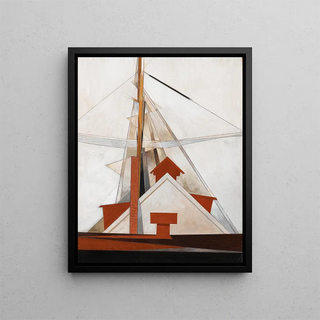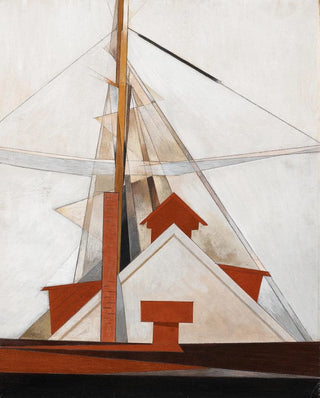Painting Masts - Charles Demuth | Art print


View from behind

Frame (optional)
Masts Art print - Charles Demuth – Captivating Introduction
In the fascinating universe of modern art, the work "Masts" by Charles Demuth stands out for its ability to capture the very essence of early 20th-century America. This canvas, imbued with symbolism and modernity, evokes not only the industrial landscape of the era but also a sense of aspiration and dynamism. Contemplating this piece, the viewer is transported to a world where geometric shapes and vibrant colors intertwine to create a visual symphony. The artist, through his unique vision, invites us to reflect on the relationship between man and his environment—a theme that still resonates today.
Style and uniqueness of the work
"Masts" is characterized by a distinctive style that combines cubism and precision. The stylized shapes of the masts, rendered with an almost architectural rigor, contrast with backgrounds in delicate tones. This geometric approach, paired with a bold color palette, gives the work depth and an almost tactile dimension. The use of light and shadow enhances this impression, creating a dialogue between the elements on the canvas. Demuth manages to evoke movement and stability, symbolizing both the power of technology and the fragility of nature. This duality makes "Masts" an emblematic work, revealing the complexity of human feelings in the face of modernity.
The artist and his influence
Charles Demuth, an iconic figure of the American art scene, made his mark with his innovative approach. Born in Lancaster in 1883, he was influenced by various artistic currents such as cubism and futurism, while developing a personal style that is uniquely his own. His work is often associated with precision and clarity, characteristics that are reflected in "Masts". Demuth was also an active member of the "Eight" group, which played a crucial role in promoting American art in the early 20th century. His impact on modern art is undeniable, inspiring many artists to explore new forms of expression and question established conventions. Through his works

Matte finish

View from behind

Frame (optional)
Masts Art print - Charles Demuth – Captivating Introduction
In the fascinating universe of modern art, the work "Masts" by Charles Demuth stands out for its ability to capture the very essence of early 20th-century America. This canvas, imbued with symbolism and modernity, evokes not only the industrial landscape of the era but also a sense of aspiration and dynamism. Contemplating this piece, the viewer is transported to a world where geometric shapes and vibrant colors intertwine to create a visual symphony. The artist, through his unique vision, invites us to reflect on the relationship between man and his environment—a theme that still resonates today.
Style and uniqueness of the work
"Masts" is characterized by a distinctive style that combines cubism and precision. The stylized shapes of the masts, rendered with an almost architectural rigor, contrast with backgrounds in delicate tones. This geometric approach, paired with a bold color palette, gives the work depth and an almost tactile dimension. The use of light and shadow enhances this impression, creating a dialogue between the elements on the canvas. Demuth manages to evoke movement and stability, symbolizing both the power of technology and the fragility of nature. This duality makes "Masts" an emblematic work, revealing the complexity of human feelings in the face of modernity.
The artist and his influence
Charles Demuth, an iconic figure of the American art scene, made his mark with his innovative approach. Born in Lancaster in 1883, he was influenced by various artistic currents such as cubism and futurism, while developing a personal style that is uniquely his own. His work is often associated with precision and clarity, characteristics that are reflected in "Masts". Demuth was also an active member of the "Eight" group, which played a crucial role in promoting American art in the early 20th century. His impact on modern art is undeniable, inspiring many artists to explore new forms of expression and question established conventions. Through his works
12,34 €






